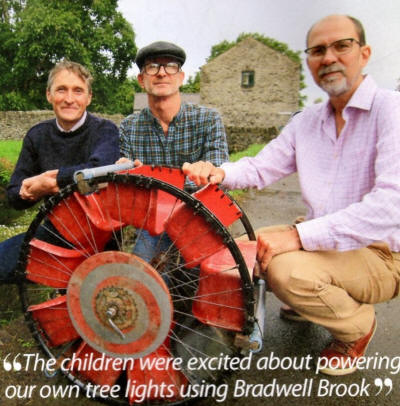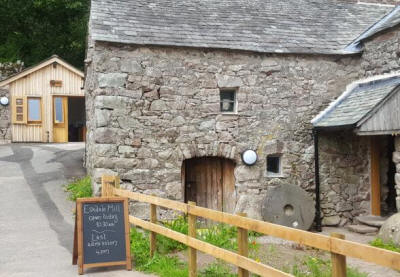|
  |
|
Page 8 |
Newsletter 127 Winter 2019 © Hampshire Mills Group |
|
News from various societies
From their newsletters
|
|
Whitchurch Silk Mill
Whitchurch Silk Mill has been celebrated at this
year’s SPACES (Society for Public Architecture,
Construction, Engineering and Surveying) awards,
following our nomination by Hampshire County Council
who were the architects on the projects.
The Mill won the Heritage and Conservation award.
Renovations and improvements to visitor facilities
at the site, the oldest working silk mill in the UK,
will help to ensure it can be enjoyed for
generations to come. The conservation project at
the Silk Mill has previously been recognised by the
Royal Institute of Chartered Surveyors (RICS), the
Royal Institute of British Architects (RIBA), and
the Campaign to Protect Rural England (CPRE).
The Mill has been included in the SPACES Yearbook,
having been chosen from over 100 entries. This
annual publication formally recognises excellence in
design and construction and promotes the development
of high-quality public buildings. SPACES is a
collaborative multi-disciplinary organisation for
building professionals working in and for the public
sector.

|
|
Mills Archive Trust
The
Rex Wailes Collection has been transferred to
the Mills Archive.


Rex Wailes (1901-1986) was the pioneer of windmill
repair. An engineer by profession, his love of
windmills began at an early age and led to a
lifelong effort to record and preserve this dying
form of technology, working closely with
organisations like the SPAB and the Newcomen
Society. His wider interest in industrial history
led to roles as consultant to the Industrial
Monuments Survey, National Trust and Royal
Commission on Historic Monuments. You can find out
more about him at:
https://millsarchive.org/explore/people/biographies/entry/111775/Rex-Wailes
The Mills Archive hopes to process the collection
and make it available to the wider public, but to do
this we need to raise about £25,000. We will launch
a public funding appeal next month and we are aiming
for early 2021, 35 years after Rex’s death, to
complete the work.
Access to the collection is not yet possible while
the archivist completes the initial processing
(which will take some months). However, for those
with a specific interest or who have memories of
Rex, we invite you to get in touch if you’d like a
glimpse of the work that goes into caring for our
collections and making them available. You can
reach archivist Nathanael Hodge directly by emailing
archivist@millsarchive.org.

|
|
Bradwell Community Hydro -
from Park Life, the Peak District National Park
Magazine
When Mike Joseph moved to Bradwell [Derbyshire]
after working for many years in the USA, he noticed
something missing at Christmas: festive lighting.
A mechanical engineer with a strong interest in IT,
Mike had previously been involved in lighting up New
York at Christmas and other high-profile
illumination projects. In 2017, he came up with the
idea for a hydro-powered Christmas display at Town
Bottom, his pictures of past displays in NYC firing
the imagination of children at Bradwell Primary
School.
|
|
“New York at Christmas always looks very striking,”
explains Mike. “It has a real wow factor and that
got the children excited about powering our own tree
lights – using Bradwell Brook, which runs through
the village.”
Joined by neighbours Richard Patton and Andy Nash,
Mike’s community hydro project resulted in six trees
being lit, powered by a hydro electric generator
built mainly from spare parts.
Richard Patton, Mike Joseph, and Andy Nash Photo:
Tom Marshall |
 |
|
Mike says: “We ran a series of classes at the
school about energy sources, looking at renewables
versus fossil fuels and the basics of electrical
generation. We talked about climate change and
greenhouse gases, discussed lighting types and LEDs,
used magnets and wires to make electricity and
looked at different designs for a water wheel. The
kids also had a competition for a lighting design
for the trees. Posters were made for the Grand
Ignition – and most of the village was there when
the lights were turned on.” The project cost £1600,
with funding from the Peak District National Park
Authority, Derbyshire County Council, and Derbyshire
Dales District Council, plus support from local
volunteer group, the Bradda Dads.
Last year, two trees were lit with more light and
colour, thanks to upgraded equipment and funding
from Breedon Cement. The benefits, however, run
deeper than merely producing festive lights, says
Mike. “By taking the children through the processes
of making electricity, we’ve demystified a
significant area of the larger world, opening a lot
of doors for curious young minds. It’s a great way
to give them a whole new way of looking at the
problems that are facing us all right now.”

|
|
Eskdale Mill, Lake District
from
Museums + Heritage Advisor website
The newly renovated
Eskdale Mill
[at Boot], the last working water-powered corn mill
in the
Lake District National Park
UNESCO World Heritage Site, has re-opened to the
public ahead of schedule [in
July 2019]. |
|
Restoration of the Grade 2 listed building was made
possible through a £1 million restoration project,
largely financed by National Lottery funding.
Through the project, both the mill’s traditional
waterwheels were restored to full working order and
a new hydroelectricity generation plant was
installed. The latter was designed to work
alongside Eskdale Mill’s waterwheels in powering the
Mill Cottage and generating income by supplying
electricity to the national grid through the Feed-in
Tariff scheme.
Following the renovation, the newly-installed
exhibition charts the mill’s history and explores
the milling processes through interactive displays,
artefacts throughout the building, and an
interactive tour.
|

from Eskdalemill.co.uk |
| |
| |
| |
  |
|
|
